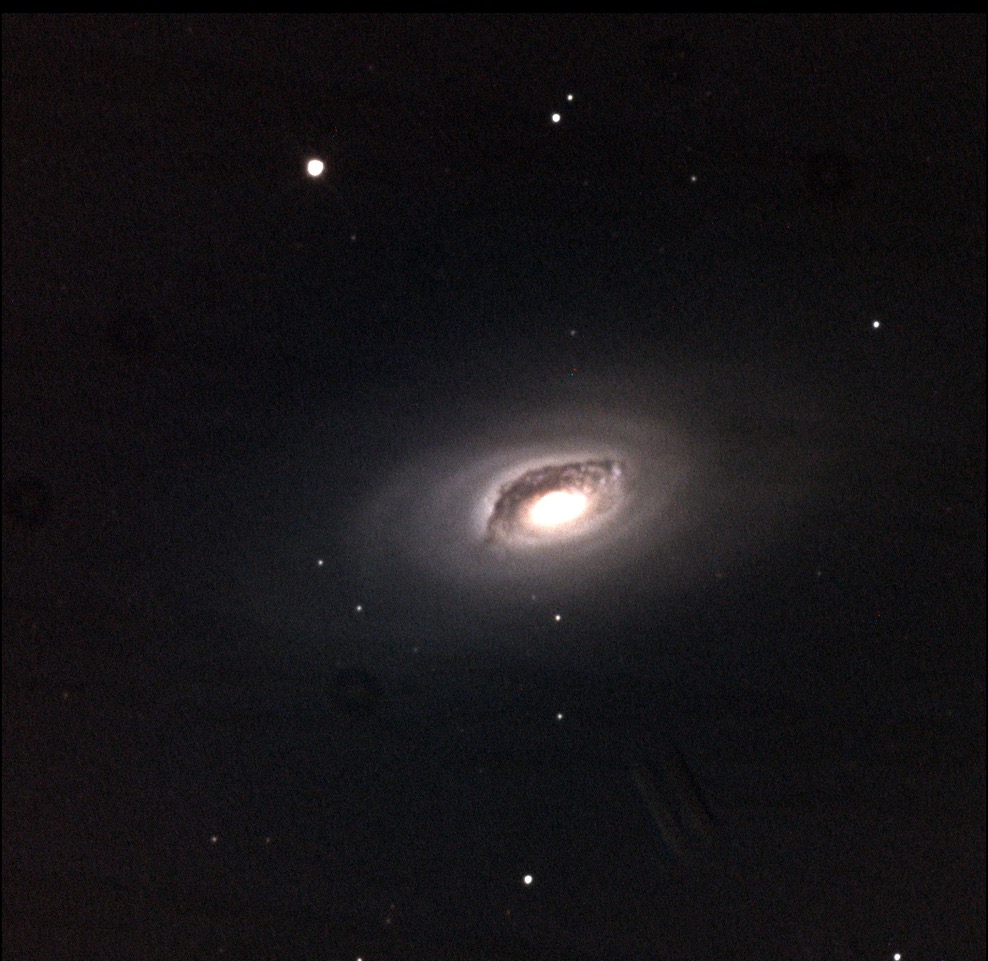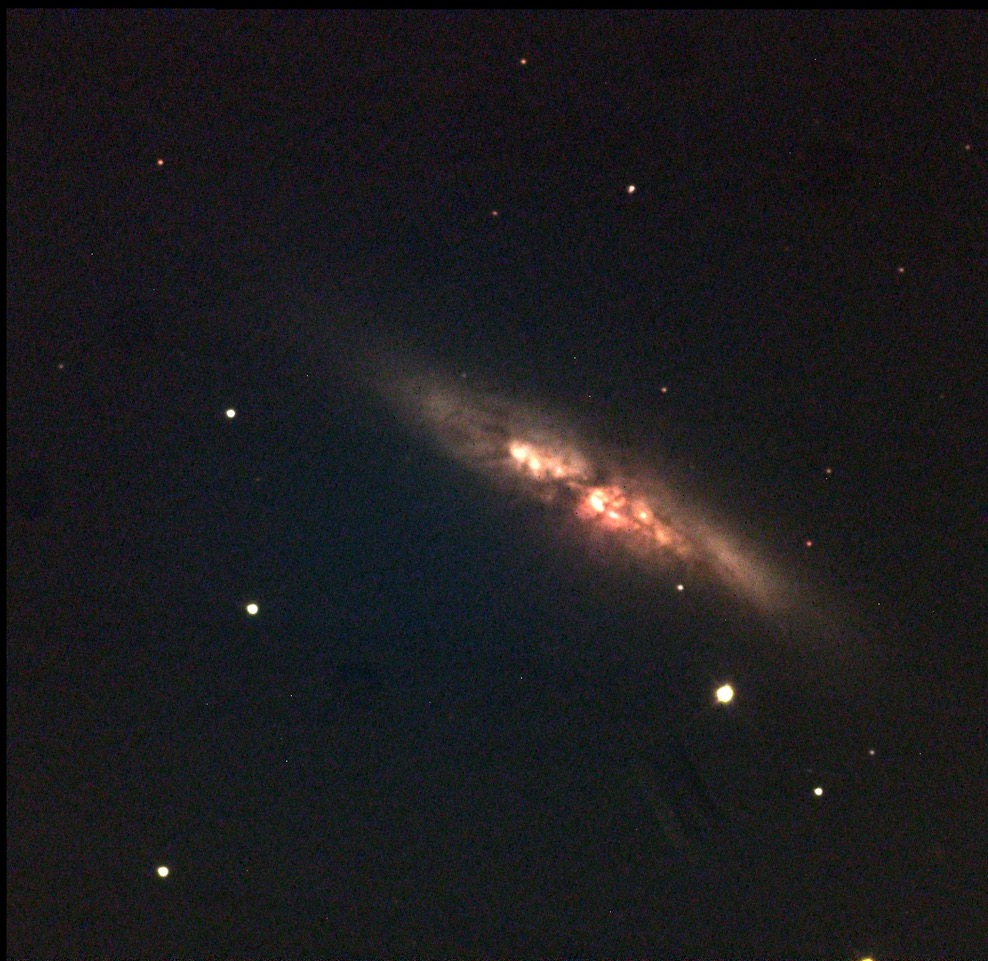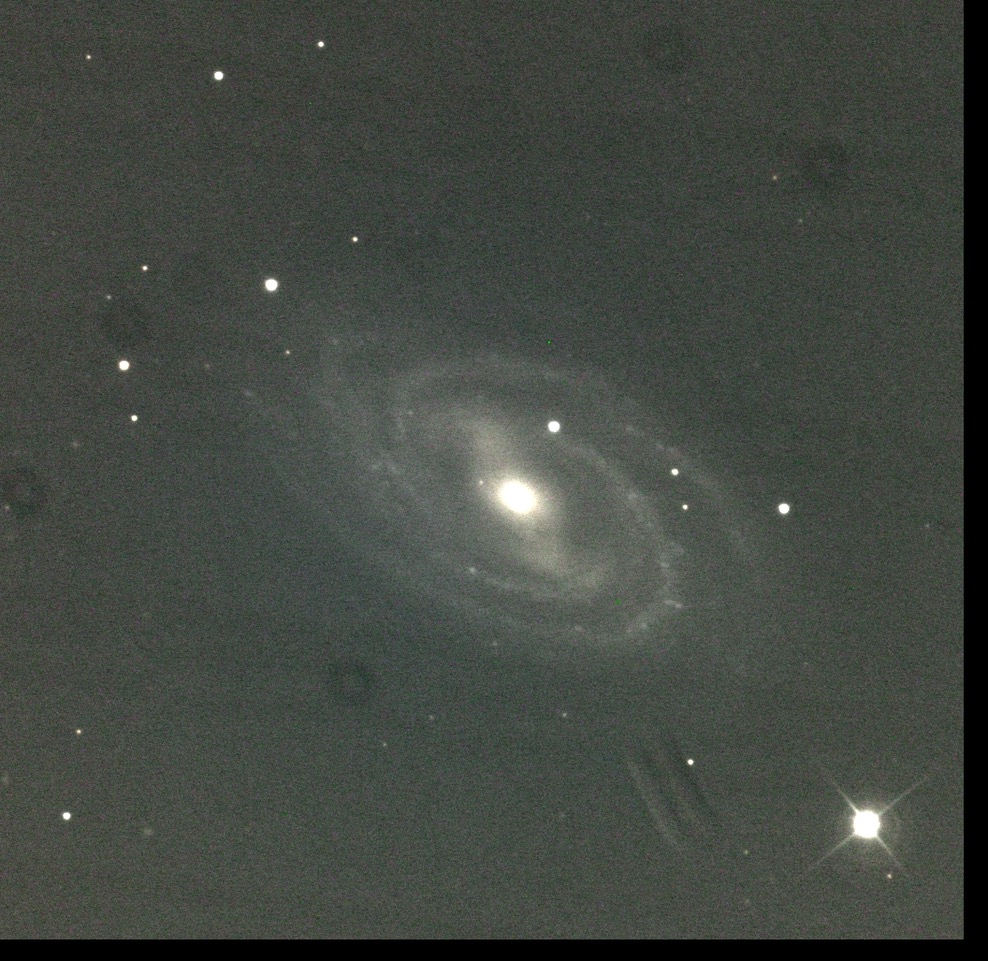… or, How the University of Saskatchewan Got its First Robotic Telescope

Nearly two years ago, in July 2018, I attended the joint Astronomy Teaching Summit & Robotic Telescopes, Student Research and Education conference in Hilo, Hawaii. It was a wonderful conference in a beautiful place, and I was fortunate to have a few extra days to spend at the ocean with my family.
 In fact, throughout the conference we were fortunate to have an amazing view of Coconut Island with Mauna Kea in the background, and when the clouds parted enough to see the peak we could even see the telescopes at the summit. (In the image to the right, you can just see them on the left peak).
In fact, throughout the conference we were fortunate to have an amazing view of Coconut Island with Mauna Kea in the background, and when the clouds parted enough to see the peak we could even see the telescopes at the summit. (In the image to the right, you can just see them on the left peak).
The conference organisers did a great job of organising activities outside the conference, including a trip to the summit where we visited the twin Keck facility (the two white domes pictured left-of-centre in the panorama).

However, the most impactful part of the trip for me was probably a presentation during the teaching summit that was given by Dan Reichart. Prior to the conference, Dan had actually sent out an invitation to everyone in the conference to sign up for accounts on Skynet.

(No, not that Skynet–but it is named after that Skynet, and the whole thing is even run through a program named Terminator).
I created the account, but didn’t think much more of it until Dan got up for his presentation. “You all should have received an email to set up a Skynet account, and I’ve given you some credits to use. We’re going to work through scheduling an observation with the robotic telescopes and then I’m going to show you some of the things your students can do with Skynet.”
 Dan walked us through scheduling an observation, and I was sitting there thinking how cool it was that I was going to collect my own image of Centaurus A without any effort, when he moved on to the analysis. He had us open a set of sample images of Jupiter and align them so that the planet would stay in the same location, then he showed us how with a click of a button we could make the movie to the left, showing the moons orbiting the planet.
Dan walked us through scheduling an observation, and I was sitting there thinking how cool it was that I was going to collect my own image of Centaurus A without any effort, when he moved on to the analysis. He had us open a set of sample images of Jupiter and align them so that the planet would stay in the same location, then he showed us how with a click of a button we could make the movie to the left, showing the moons orbiting the planet.
Then he showed us a bit of software that would allow us to model the orbital parameters and determine Jupiter’s mass. There’s an old CLEA program that does this with simulated data, which we’ve had first-year astronomy students do for years. It’s a neat piece of software, and probably my favourite of the CLEA simulations–but this was really next level! Dan also noted that Afterglow, the web-based software developed for Skynet, could be used to do things like process variable star light curves in a small fraction of the time it takes with other software. That, and the fact that it’s so user-friendly opens up possibilities that students can do in first year of university that we’ve struggled to manage teaching in senior courses.
I’ll say a little more about this last point right away, but first the cherry on the top. Because yes, Skynet is a great teaching tool, and if you know anything about the stuff I mentioned in the last two paragraphs you’ve already recognised that it’s the coolest thing ever. But if that’s the case, then you’re not a first-year university student who probably likes space stuff but maybe isn’t all that cracked up about data analysis. And for those people, Dan had something else. He took us back to the movie and told us to click a button that would adjust the image contrast, then another button to equalise the contrast over all the images in the movie, and WOW, was that ever cool! Click here to see the result (opens in a new tab).
The bands. The great red spot. The shadow of one of Jupiter’s moons on its surface. And anyone could make this movie. Using data they’ve collected on their own. With a professional telescope.
I was gobsmacked. Totally sold. My students were doing Skynet-based labs next year. The following day, Dan gave a talk about the effect of Skynet’s Our Place in Space! labs at the University of North Carolina, but I already knew the result because I had seen what Skynet could do. >100% enrolment in Astronomy classes in 5 years. 20% of all undergrads take Astronomy courses. Astronomy majors increased 300%. Paved the way for two tenure-track hires. Of course that was the result.
I had all kinds of questions for Dan after that, but the biggest one was “what do I need to do to automate our old rolloff enclosure out at Sleaford, and get a telescope set up on Skynet?” Well, as it turns out, there’s a fair bit to coordinate. This was going to be a long-term project, but a good one to be thinking about and start working towards.
In the meantime, our students could still use Skynet, and I told Dan I’d adopt the OPIS! labs in my January class. This was good because I was able to join Dan on Hangouts as he went through the labs with his TAs during the fall term.
At this point, I should really note that I’m not the first person from the University of Saskatchewan Dan has ever met. Actually, not by a long shot. As far as I know, I’m the fourth of five so far.
The first person from the U of S who had something to do with Dan was Gordon Sarty. Gord is currently the Department Head in Psychology. He builds MRI machines to put in space at his day job, but he also has a strong interest in Astronomy and has supervised a number of Astronomy students in the Physics & Engineering Physics Department. And it turns out Gord used Skynet’s Pancromatic Robotic Optical Monitoring Polarimetry Telescopes (PROMPT) a number of years ago and published a paper (co-authored with Dan) with the data he collected.
 The next two people from the U of S to meet Dan were students, Ashley Stock and Chelsea-Lea Randall. Both had attended Dan’s Educational Research in Radio Astronomy (ERIRA) summer class a couple of years before I met Dan in Hawaii.
The next two people from the U of S to meet Dan were students, Ashley Stock and Chelsea-Lea Randall. Both had attended Dan’s Educational Research in Radio Astronomy (ERIRA) summer class a couple of years before I met Dan in Hawaii.
I didn’t know any of this when I met Dan, so I was surprised when he said he’d met some of our students, and that another one (Riley Whyte) was on his way to ERIRA the following month. It turns out Dan has even driven through Saskatchewan, on his way to deliver a clamshell dome to Athabasca University for the PROMPT telescope they’ve installed there.
So, in fall 2018 I was having weekly meetings with Dan as he ran through the labs we’d be running the following term. Ashley was my TA the following term, so she joined as well, to see how the labs would go. She was working on her Engineering Physics capstone design project that year, working with a few other students to design a receiver for the 8-m radio dish we have on 115th St, and was able to ask Dan some questions about that as well.
The Skynet labs and research projects that Ashley and Riley ran the following term were a huge success, culminating in a research poster presentation at the Observatory in April 2019. This year, we ran similar projects–with Rina Rast taking over Ashley’s TA position as she has moved to the University of Toronto for her PhD–but we’ve had to postpone the poster presentations until the university reopens following COVID-19 physical distancing restrictions–so please stay tuned! However, some of the groups have published their work on this site, which you can find in the Student Research category. We’ll continue using this blog to share student research and other observatory-related activity even after we’re back on campus, so please subscribe to our email list at the site menu to receive notifications when new posts are added!
Now, back to the USask-Skynet story. At some point in September or October 2018, Dan mentioned that he might have a telescope available–at least, an optical tube, but it would likely need a mount and camera (it did)–and asked if I’d be interested in setting it up in our rolloff enclosure. It turned out that Dan was moving some of the PROMPT telescopes from Cerro Tololo Inter-American Observatory (CTIO) Chile, repurposing them for another application. The PROMPT telescopes were originally set up in a cluster at CTIO to hunt Gamma-Ray Bursts to carry out optical follow-up in multiple filters, and actually detected the GRB (050904) that held the distance record (z=6.3) from September 2005 to September 2008.
But now Dan had a new project in mind: gravitational waves. It turned out that in addition to the GRB record, one of the PROMPT telescopes had also been one of the first to detect the optical counterpart to GW170817, which ushered in a new era of multi-messenger astronomy after LIGO and Virgo detected gravitational waves from a kilonova that was subsequently observed across the electromagnetic spectrum.
Since gravitational wave optical source detection does not require observations with multiple filters, the PROMPT telescopes could be redeployed around the world to increase the opportunity to have a telescope under clear dark skies when a gravitational wave signal is detected. And since the PROMPT telescopes all have identical optical tubes and cameras, a single set of baseline images, of all the galaxies out to 200 million light-years, can be used by all of them for comparison when looking for the new point of light from a kilonova.
That, in a nutshell, is currently the principal research intent of the PROMPT telescopes.
This exciting opportunity–for the University of Saskatchewan to be part of this project while adding capacity for our students–was awarded funding from the College of Arts & Science Dean’s Priority Fund that fall, and we began preparations for hosting the telescope.
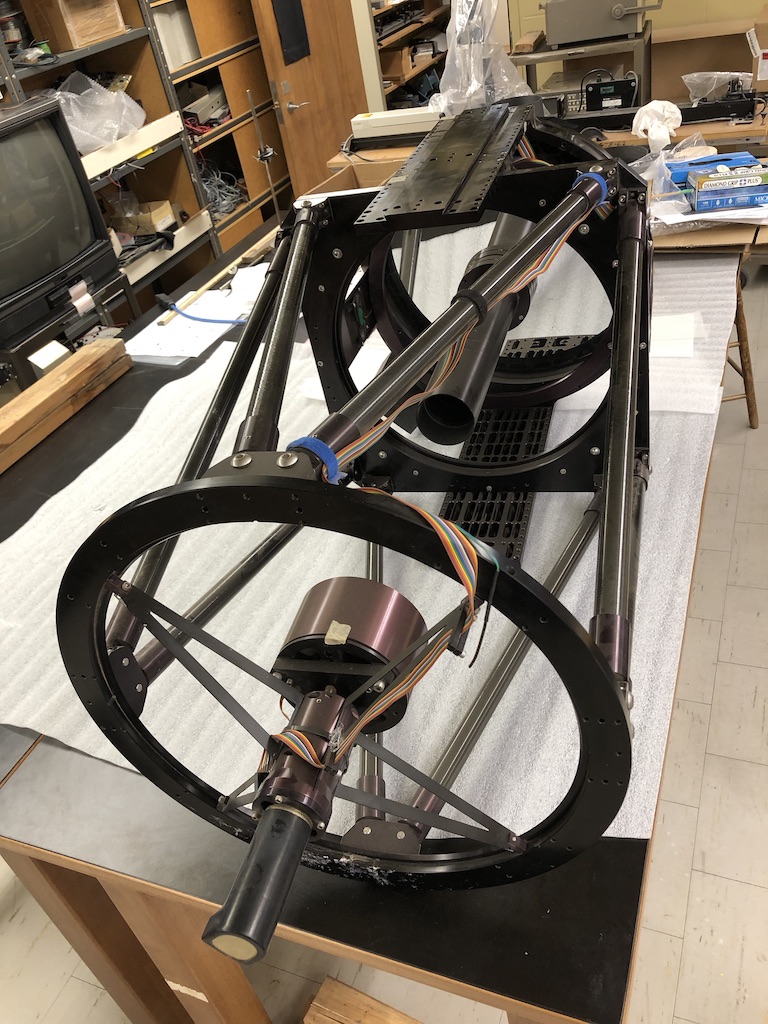 These funds would eventually cover the camera, filter wheel and spacer needed for focusing, the cloud sensor, rolloff roof control system, a fence to ensure people’s hands can’t get pinched, the pier and wedge for mounting the telescope, the internet installation, and some operating costs. Dan was able to obtain funds for Skynet to purchase the telescope mount, and by spring we were all geared up to execute the project. The first piece of the telescope–the optical tube from CTIO–arrived on April 4, 2019. From that point, the project took a little over a year to complete, with many partners involved.
These funds would eventually cover the camera, filter wheel and spacer needed for focusing, the cloud sensor, rolloff roof control system, a fence to ensure people’s hands can’t get pinched, the pier and wedge for mounting the telescope, the internet installation, and some operating costs. Dan was able to obtain funds for Skynet to purchase the telescope mount, and by spring we were all geared up to execute the project. The first piece of the telescope–the optical tube from CTIO–arrived on April 4, 2019. From that point, the project took a little over a year to complete, with many partners involved.
A lot of the construction at the site happened in May-June 2019. The basic plan came together through a couple of site trips that I made with Scott Noble from Mechanical Engineering, and Ted Toporowski from the Physics Machine Shop.
 We recognised that the safety switching could be greatly simplified with a couple of simple modifications. To start, the flap at the west end of the building (pictured laid down in the above image) would be bolted up, and the flap on the east end would be attached to the roof. Therefore, the roof would simply roll off and on without any other moving parts. Furthermore, this would provide enough clearance for the telescope to be left in any position while the roof moves, so we would not have to add electronic switches to ensure it parked properly before closing the roof. And for the safety of anyone who might be on the site when the roof is moving, we would install a 6-foot fence a few feet away from the building all around, with gravel inside to keep the weeds down, and add a lockout switch that would cut power to the roof if the gate were opened. Finally, since the roof seemed to require a helping hand when rolling off, we would work on levelling the casters and considered replacing the drive system, to go from a steel cable pulled by a rubber wheel to a chain and sprocket.
We recognised that the safety switching could be greatly simplified with a couple of simple modifications. To start, the flap at the west end of the building (pictured laid down in the above image) would be bolted up, and the flap on the east end would be attached to the roof. Therefore, the roof would simply roll off and on without any other moving parts. Furthermore, this would provide enough clearance for the telescope to be left in any position while the roof moves, so we would not have to add electronic switches to ensure it parked properly before closing the roof. And for the safety of anyone who might be on the site when the roof is moving, we would install a 6-foot fence a few feet away from the building all around, with gravel inside to keep the weeds down, and add a lockout switch that would cut power to the roof if the gate were opened. Finally, since the roof seemed to require a helping hand when rolling off, we would work on levelling the casters and considered replacing the drive system, to go from a steel cable pulled by a rubber wheel to a chain and sprocket.
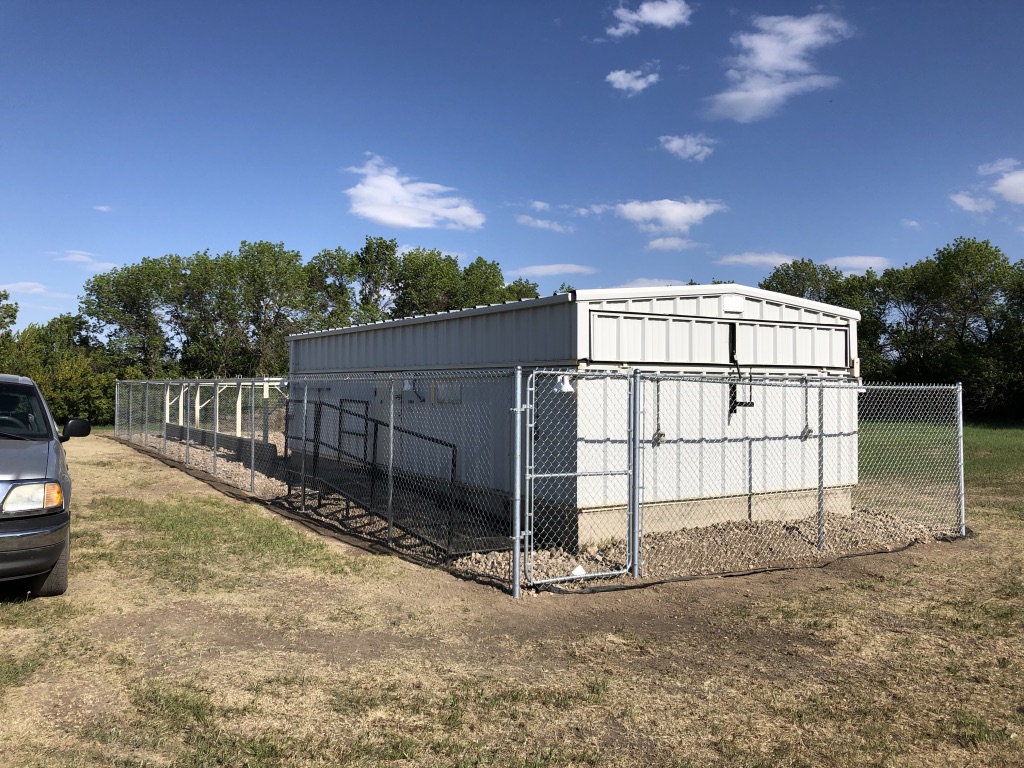 At the same time the construction was happening, we also began sourcing electronics. A cloud sensor and dome controller were needed, so we purchased a Boltwood II cloud sensor and MaxDome II from Diffraction Limited in Ottawa. To get high-speed internet on site, we contracted Redbird Communications, who would install a dish on a 50-ft power pole to communicate via radio frequency link to their tower in Bradwell, roughly 25 km away. To be effectively used for gravitational wave follow-up, the camera required the same CCD chip as the other PROMPT telescopes, so an FLI 4710 and 20-position filter wheel were purchased. Finally, we needed a rugged computer that could function in the extreme Saskatchewan temperatures, and security cameras for monitoring the site.
At the same time the construction was happening, we also began sourcing electronics. A cloud sensor and dome controller were needed, so we purchased a Boltwood II cloud sensor and MaxDome II from Diffraction Limited in Ottawa. To get high-speed internet on site, we contracted Redbird Communications, who would install a dish on a 50-ft power pole to communicate via radio frequency link to their tower in Bradwell, roughly 25 km away. To be effectively used for gravitational wave follow-up, the camera required the same CCD chip as the other PROMPT telescopes, so an FLI 4710 and 20-position filter wheel were purchased. Finally, we needed a rugged computer that could function in the extreme Saskatchewan temperatures, and security cameras for monitoring the site.
The fence was purchased from Nordic Fencing along with a 15-ft pole for mounting the security cameras and cloud sensor. Craig Gavelin was a summer student hired to help Scott design the control wiring, and he came out with me a couple of days, along with Darrell Chatfield of the RASC, to build the fence and shovel gravel.
The power pole for the internet dish and the camera/cloud sensor pole were installed by Affleck Contracting one day while I continued working on the fence (and videotaped the process).
With the poles in place, we were able to trench in a sprinkler hose to run the ethernet cable underground. My father-in-law, Darcy Johnson, happened to be in town for this and we spent a very productive couple of days out there–trenching, running the sprinkler hose, installing the cameras, bolting the side flaps in place on the rolloff shelter, shimming up the track so the roof could roll off onto a level surface, and tightening the drive cable, which turned out to be all that was needed to get the roof moving reliably.
This work was mostly complete by the end of June, 2019–apart from the ties for the chain link fence, which my wife, Kim, and son, Jonas, spent a day installing in September while we set up for the annual Sleaford open house. Craig and Scott worked on the control wiring through the summer, and Scott completed it during the fall term. In December it was ready to install, so Redbird came out and set up their dish and ran the ethernet cables into the building for the internet and security cameras. I went out after that with my dad, Don Janzen, to install the conduit so we would be able to run all the control wiring. And, just before the holiday break, Scott and I spent a couple of days setting everything up, with the final test open/close controlled from my kitchen counter and recorded on the security cameras.
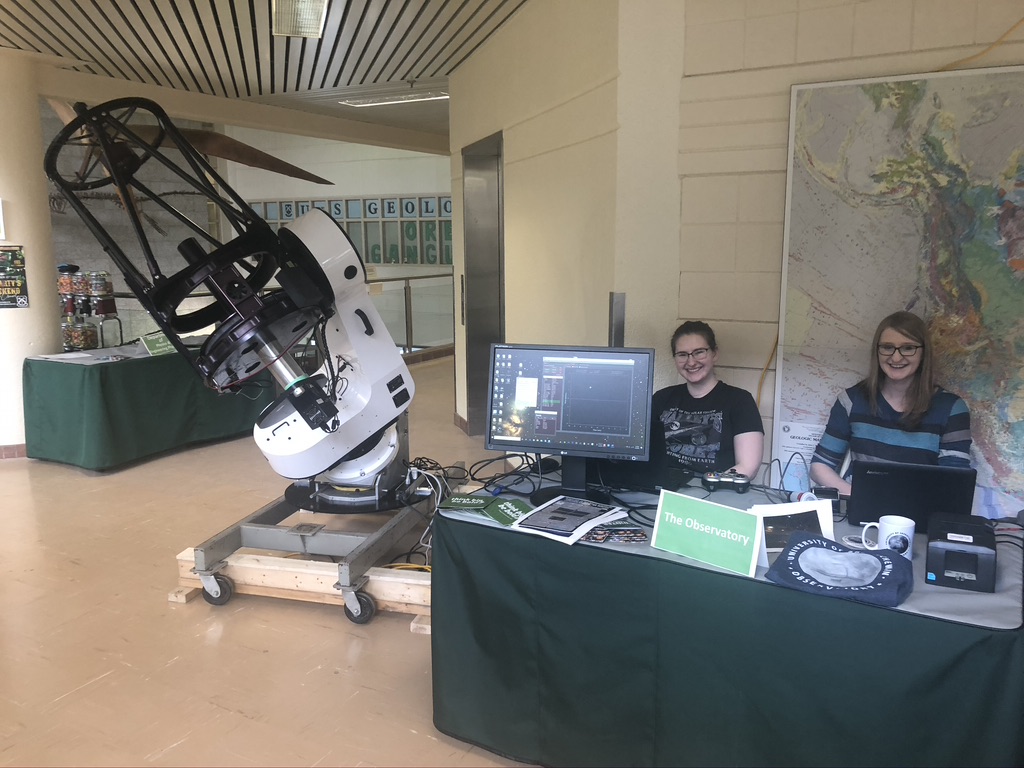 The mount arrived in February of this year, and the guys in the Physics Machine Shop–James McGregor, Ian Knutson, and Ted Toporowski–machined a spacer to attach the camera at the telescope’s focal plane and built a cart and equatorial wedge to mount the telescope so we could measure its height and determine how high to build the pier so the telescope could not get in the way of the roof opening and closing.
The mount arrived in February of this year, and the guys in the Physics Machine Shop–James McGregor, Ian Knutson, and Ted Toporowski–machined a spacer to attach the camera at the telescope’s focal plane and built a cart and equatorial wedge to mount the telescope so we could measure its height and determine how high to build the pier so the telescope could not get in the way of the roof opening and closing.
This part of the work, which also involved getting the mount, focuser, camera and filter wheel all up and running, coincided with the Arts & Science College Plan 2025 Celebration Day on March 2, so we borrowed a cart with casters from the Plasma Physics Lab so we could roll it over to the Geology Building that day.
After that, we designed the pier, which turned out to only be 6.5-inches high, dismantled the telescope so it could be shipped, and sent the aluminum wedge and adapter out to be anodised.
 Everything was about a week from being ready when COVID-19 hit and the university shut down. Ted got permission to go in and build the pier on the final day before the university closed, and Kim and I loaded everything into our car and brought it all back to our garage, including the wedge Ted had just built and some spray paint to finish it.
Everything was about a week from being ready when COVID-19 hit and the university shut down. Ted got permission to go in and build the pier on the final day before the university closed, and Kim and I loaded everything into our car and brought it all back to our garage, including the wedge Ted had just built and some spray paint to finish it.
Initially, we were not given permission to access the site to set up the telescope, but eventually I did get permission for Kim and I to go out by ourselves and assemble the telescope, which we did on April 23. After a couple more trips out–to cut out the floor where the motor for the telescope’s secondary mirror could actually run into it if it were to swing downwards, and to polar align the wedge–the telescope saw first light in Skynet mode, with fully-automated roof opening and image capture, on April 30, 2020. We chose for the occasion to image the bowtie nebula, NGC 40 (pictured at the top of this post), which indeed came fully dressed up for the occasion.
In addition to this first light image, the following are the initial set of images I’ve taken over the last few nights, which will be shared at sunset on our social media platforms as part of an #AstronomyAcrossCanada initiative in partnership with other science centres across the country in celebration of International Astronomy Day.

